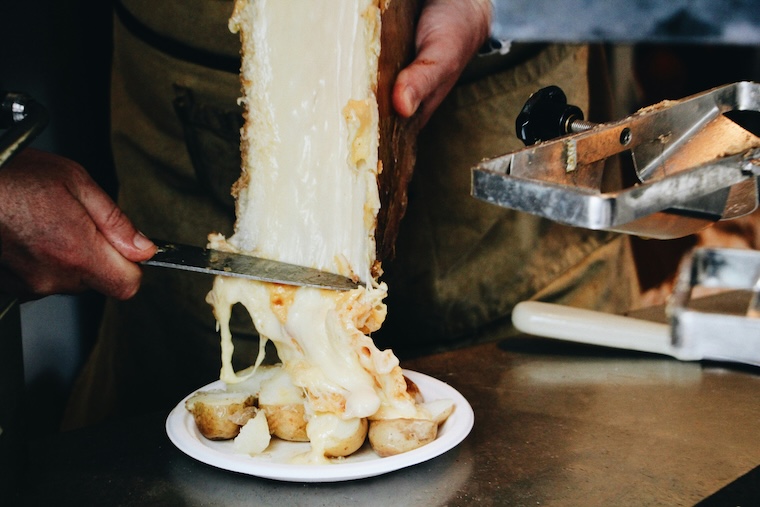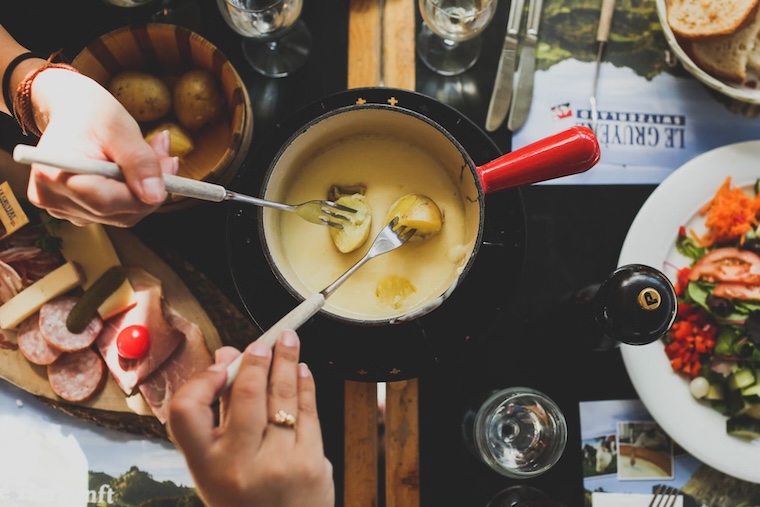Savoyard cuisine is a celebration of hearty mountain food, rich traditions, and local ingredients. Originating from the pays de Savoie, this rustic culinary heritage was shaped by the alpine lifestyle, where nourishing, high-calorie meals were essential for withstanding harsh winters.
Today, these traditional dishes are at the core of the region’s identity, offering comforting flavors and convivial dining experiences—perfect for sharing entre amis after a day of skiing or hiking. From creamy cheese dishes to robust mountain specialties, exploring cuisine savoyarde is a must for anyone visiting the Haute-Savoie region.
Table of Contents
What are the traditional Savoyard dishes?
Savoyard cuisine is renowned for its rich, comforting dishes, often featuring melted cheese, hearty meats, and local potatoes—perfect for warming up after a day in the mountains. Here are some of the most iconic dishes you must try:
Cheese-based specialties
- Fondue savoyarde
A quintessential mountain dish where a blend of local cheeses—Comté, Tomme de Montroc, and Abondance—is melted with a splash of vin blanc de Savoie. Served with crusty bread for dipping, it’s the perfect sharing dish for a cozy meal entre amis. - Raclette de Savoie
A traditional dish where a wheel of cheese is melted and scraped over boiled pommes de terre, served with charcuterie and pickles. A warm, interactive meal ideal for long winter evenings. - Tartiflette
Made with creamy Reblochon de Savoie (or the locally made Vallorcin from Ferme de Vallorcine), layered with pommes de terre, lardons, oignons, and a touch of cream—this rich, gratinated dish is a symbol of Haute-Savoie comfort food. - Croûte au fromage
A rustic alpine favorite: bread soaked in white wine and covered with melted cheese, often served with a green salad for a lighter accompaniment.
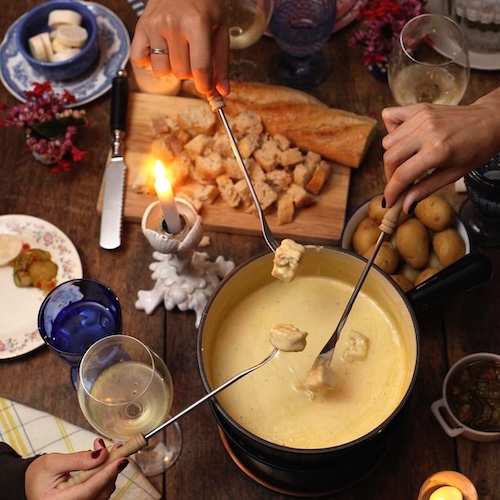
Hearty mountain dishes
- Gratin de crozets
A comforting dish made with crozets, small square-shaped pasta typical of the region, baked with Comté cheese and cream—perfect after a day on the slopes. - Diots au vin blanc
Savoie sausages slow-cooked in white wine with onions and herbs, often served with pommes de terre or polenta for a hearty, flavorful meal. - Poêlée montagnarde
A mountain sauté of potatoes, cheese, lardons, and onions, offering a satisfying taste of the region’s rustic culinary roots. - Farcement
A unique blend of grated pommes de terre, bacon, raisins secs, and fruits secs—baked slowly to create a dish that’s both sweet and savory.
Desserts
- Gâteau de Savoie
A light, airy sponge cake originating from the duché de Savoie, known for its fluffy texture and delicate sweetness—perfect with a dusting of powdered sugar. - Tarte aux myrtilles
A classic mountain dessert made with wild blueberries, offering a refreshing balance of sweetness and tartness, often enjoyed in the summer months.
What is the history of Savoyard cuisine?
The roots of Savoyard cuisine trace back to the humble, resourceful traditions of mountain life in the pays de Savoie. Shaped by harsh winters, isolation, and limited resources, early alpine communities developed hearty, nourishing meals using local ingredients that could be stored or preserved through the colder months.
Alpine origins and culinary traditions
Historically, the region’s diet revolved around staple foods that were easy to grow and store pommes de terre, grains, and dairy products from mountain pastures. Shepherds and farmers relied on cheese, potatoes, and cured meats to sustain them through long, snowy winters.
Influence of neighboring cultures
Bordering both Switzerland and Italy, the Savoie region absorbed culinary influences from its neighbors. This resulted in a rich fusion of flavors, blending French rustic traditions with Swiss cheese-making expertise and Italian pasta influences seen in dishes like crozets and the famous gratin de crozets.
Evolution from peasant fare to gourmet cuisine
While Savoyard cuisine originated as simple, rustic fare, it has evolved into a celebrated gastronomic tradition. Today, these dishes are found in high-end restaurants and cozy mountain chalets alike, offering an authentic taste of alpine heritage. Ingredients like tomme, Reblochon, and vin blanc de Savoie reflect the region’s commitment to local craftsmanship and culinary excellence.
What ingredients are used in Savoyard cuisine?
The richness of Savoyard cuisine lies in its use of simple, high-quality ingredients sourced from the pays de Savoie. These local products reflect the alpine landscape, offering comforting, hearty flavors that have stood the test of time.
Iconic cheeses
Cheese is at the heart of cuisine savoyarde, with each variety offering distinct flavors and textures:
- Reblochon de Savoie: Creamy and rich, essential for the classic tartiflette.
- Tomme de Montroc: A local specialty from Montroc, offering a mild, nutty taste perfect for melting.
- Vallorcin: A rare cheese from Vallorcine, similar in texture and flavor to Reblochon.
- Abondance: A semi-hard cheese with fruity, buttery notes, ideal for melting into fondue savoyarde.
- Comté: A mature, nutty cheese often used in dishes like gratin de crozets and fondue.
Hearty vegetables and grains
Root vegetables and grains form the foundation of many traditional dishes:
- Pommes de terre: Essential in dishes like tartiflette, poêlée montagnarde, and farcement.
- Crozets: Small, square-shaped pasta made from buckwheat or wheat, featured in comforting gratins.
- Polenta: Often served as a side with dishes like diots au vin blanc.
Local meats and charcuterie
Savoyard cuisine features flavorful meats, often slow-cooked or cured:
- Diots: Savoie sausages typically cooked in white wine.
- Pormoniers: Herb-infused sausages made from pork and spinach or chard.
- Jambon cru de Savoie: Cured ham, commonly served with cheese dishes like raclette.
Regional wines and aromatics
- Vin blanc de Savoie: A key ingredient in dishes like fondue savoyarde and often paired with cheese-based meals.
- Herbs and spices: Thyme, rosemary, bay leaves, and nutmeg (especially in creamy dishes) are frequently used to enhance flavors.
These ingredients reflect the region’s deep connection to the land and its culinary traditions, offering authentic flavors that define the essence of the Haute-Savoie.
What are the best wines to pair with Savoyard dishes?
The rich, comforting flavors of Savoyard cuisine are perfectly complemented by the region’s crisp, aromatic wines. Known for their freshness and minerality, wines from the pays de Savoie enhance the creamy textures and hearty ingredients of traditional dishes.
White wines: The perfect match for cheese-based dishes
- Apremont: A light, dry wine with floral notes, ideal for pairing with fondue savoyarde or a classic raclette de Savoie.
- Chignin-Bergeron: A fuller-bodied white with hints of apricot and honey, perfect for richer cheese dishes like croûte au fromage and gratin de crozets.
- Roussette de Savoie: Known for its floral and fruity notes, this wine pairs beautifully with lighter dishes, fish, or cheese-based meals such as tartiflette.
Red wines: Robust pairings for hearty meat dishes
- Mondeuse: A bold red wine with peppery undertones, ideal for complementing rich meat dishes like diots au vin blanc or pormoniers.
- Gamay de Savoie: A lighter red that pairs well with charcuterie and mountain specialties like poêlée montagnarde.
These wines highlight the flavors of traditional cuisine savoyarde, enhancing every meal with the distinct character of the French Alps.
Where to find Savoyard restaurants in Chamonix?
Chamonix is the perfect place to experience authentic cuisine savoyarde, offering a variety of restaurants that celebrate the region’s rich culinary heritage. From cozy mountain chalets to refined gourmet dining, here are some of the best spots to enjoy traditional plats savoyards.
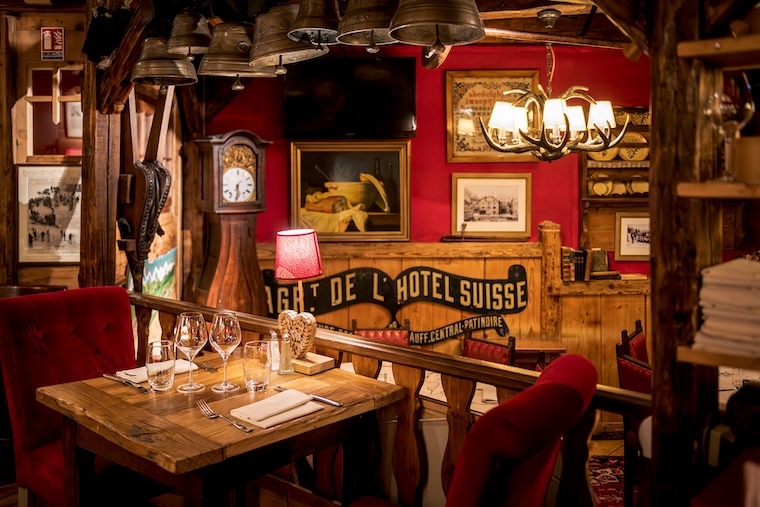
Authentic Savoyard experiences
- La Calèche
A charming, rustic restaurant in the heart of Chamonix, known for its traditional ambiance and classics like fondue savoyarde, raclette de Savoie, and tartiflette. - Le Monchu
Located near the town centre, this restaurant offers a warm alpine atmosphere and a menu packed with regional specialties, including croûte au fromage and gratin de crozets. - La Maison Carrier
Offering a refined take on cuisine traditionnelle, this restaurant focuses on seasonal ingredients and local flavors, including dishes made with tomme de Montroc and reblochon de Savoie.
Cozy mountain chalets
- La Bergerie de Plan-Praz
Situated at the top of the Planpraz cable car, this chalet offers breathtaking views of the Mont Blanc massif alongside hearty mountain dishes like poêlée montagnarde. - Café comptoir
A gastronomique take on Savoyard classics, perfect for enjoying dishes in a charming chalet in Vallorcine.
Whether you’re seeking a cozy dinner entre amis or a gourmet experience with panoramic views, Chamonix offers an unforgettable journey through the flavors of Savoyard cuisine.
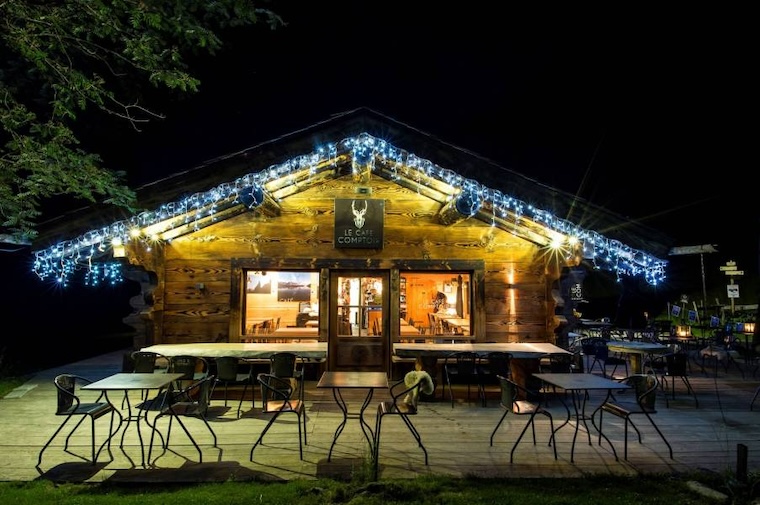
Conclusion
Exploring Savoyard cuisine is an essential part of any visit to the French Alps. Rooted in the traditions of the pays de Savoie, these hearty, flavorful dishes embody the warmth and conviviality of mountain life. From the rich, cheesy comfort of fondue savoyarde and raclette de Savoie to the sweet simplicity of a classic gâteau de Savoie, every bite reflects centuries of culinary heritage.
Pairing these traditional meals with a glass of vin blanc de Savoie or a robust Mondeuse elevates the dining experience, bringing out the best of this alpine gastronomy. Whether you’re dining in a cozy chalet or a refined restaurant in Chamonix, the authentic flavors of cuisine savoyarde promise unforgettable moments to share entre amis.
